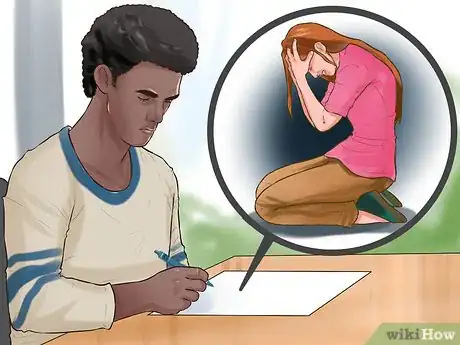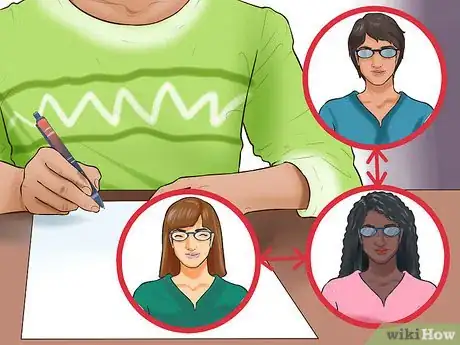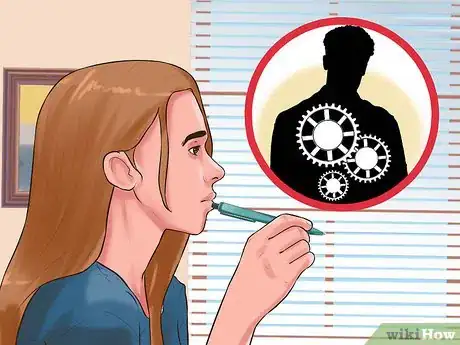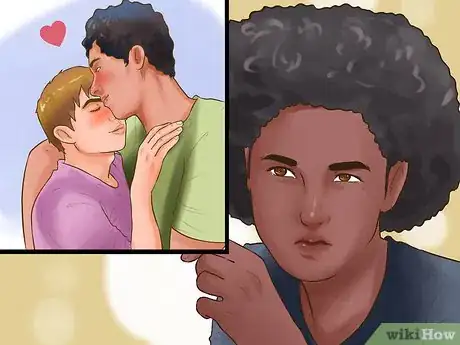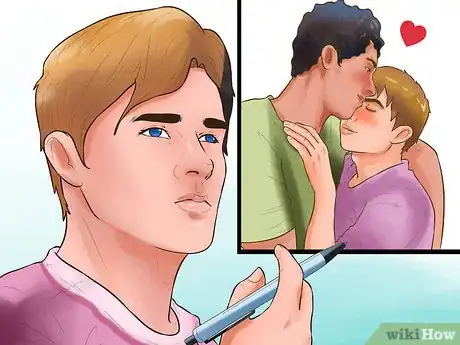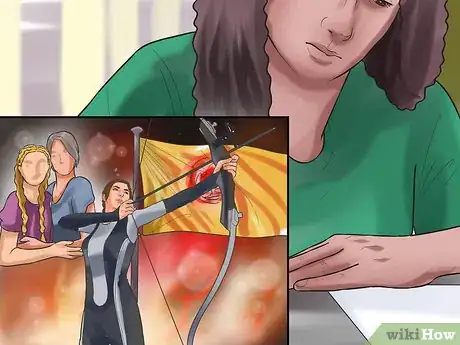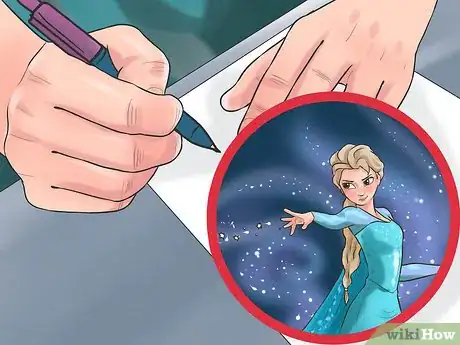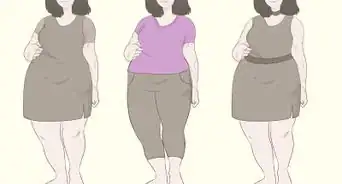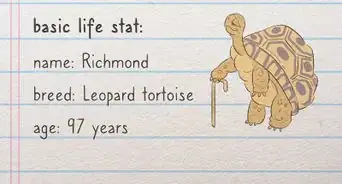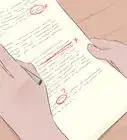This article was co-authored by Lucy V. Hay. Lucy V. Hay is an author, script editor and blogger who helps other writers through writing workshops, courses, and her blog Bang2Write. Lucy is the producer of two British thrillers and her debut crime novel, The Other Twin, is currently being adapted for the screen by Free@Last TV, makers of the Emmy-nominated Agatha Raisin.
This article has been viewed 28,035 times.
All writing—whether for books, movies, or the stage—walks the line between old and new. Audiences appreciate novel and exciting storylines, while being unconsciously drawn to formula and convention. One way to keep your story exciting is to avoid flat, stereotypical characters. You can do this by working to establish nuanced details about your characters, using plot circumstances to shape your characters, and by being especially careful to write strong female characters.
Steps
Establishing Details About Your Characters
-
1Make a list of your favorite characters. For each one, write down basic demographic details (age, gender, physical appearance). Then ask yourself, what makes each of these characters unique? How do each of these characters stand out? Use this list to inspire your writing.[1]
- Walter White in Breaking Bad, for example, is a white, male, middle-aged school teacher, but he also becomes a ruthless drug lord.
- These qualities shape Walter White and all of the decisions (and emotional reactions) he makes.
-
2Figure out your main character’s “wants” and “needs.” You probably understand that the desires of your main character are what will drive the plot, but these desires will also shape the substance of your main character. Consider what your character wants (this is a conscious desire) versus what your character needs (an unconscious desire). Allow the nuances of your character to develop out of these wants and needs.
- The character of Clarice Starling in The Silence of the Lambs wants to succeed and advance within the FBI, but deep down she also needs acceptance (probably from a parental figure).
- Both her wants and needs lead her to engage with Hannibal Lecter, but in different ways, thus giving her character nuance.
Advertisement -
3Determine your character’s “wounds.” All good characters have “wounds” they have incurred through their lives. These old scars can have a huge influence over how characters act, what they are afraid of, and what they insulate themselves from. If you can determine your character’s wounds, you can better write a round and interesting person into being.[2]
- For example, Don Draper in Mad Men is actually an army deserter named Dick Whitman.
- This is his biggest wound and biggest secret, and it drives much of what he does and how he acts.
-
4Try flipping an identity marker. One way to check for stereotypical writing is to imagine you’ve flipped one of your character’s identity markers. Although some elements of your character would understandably change based on these identity markers, you should always have a deeper, more complex reasons for what your character does (and how they act) than a simple identity marker. If everything about your character comes undone with the flip of one identity marker, chances are you are relying on a stereotypical representation. This exercise helps to check for that kind of sloppy writing.
- Let’s say you’ve written a 26-year-old, black, female detective.
- Every once in a while, stop and mentally change some of her characteristics in a given scene.
- Imagine that she is a 26-year-old white woman, or a black man, or a much older black woman.
- How do her decisions and/or reactions change or stay the same?
-
5Look for “defining characteristics.” When crafting your characters, try to determine each character’s defining characteristics. Try to distill the essence of your character down to one or two key features. If you find the essence of your character to be that “she’s a girl” or “he’s a gay man,” you likely have a flat or stereotypical character. Search for something more specific, more unique, and ultimately more interesting.
- The character Lisbeth Salander in the film The Girl with the Dragon Tattoo is a whip-smart, socially withdrawn computer hacker with a traumatic past.
- The fact that she is a woman is important, but these other defining characteristics are what drive her.
Using Circumstances to Shape Your Characters
-
1Focus on the “inciting incident.” In a traditional plot structure, there is always an “inciting incident,” or something that happens that sets the main character’s story in motion. If you can think carefully about an interesting inciting incident, it can tell you unique things about your character.[3]
- Thinking again about Walter White, the inciting incident in Breaking Bad is that Walt finds out he has very advanced cancer.
- His reaction to this news is what drives the plot line of the entire series, but more importantly, his reaction reveals who is an a person.
-
2Challenge genre conventions. It is not uncommon to find certain types of stereotypical characters housed within particular types of stories. (Horror movies, for example, are known for having a virginal female character who lives, and a promiscuous one who dies early). You can widen the scope on your character’s personalities by straying from the convention of your given genre. Try to include some plot elements or details that are unique or out of the ordinary for the genre you’re working in, and see how that influences the way you write your characters.[4]
- The film Gone Girl challenges the mystery-suspense genre, by supplying an unreliable narrator, and the unique character of Amy Dunne is created.
-
3Introduce your character in action. Rather than writing a lot of exposition that explains who you character is, show who your character is through action. Place your character in a situation, and figure out how they act (or react). The more unique the situation, the more you push yourself to think outside of the box. You may surprise yourself with the unique details you come up with.[5]
- The family dinner scene that happens near the beginning of Little Miss Sunshine provides each character with an opportunity for introduction and reaction.
- This scene is an excellent example of how to introduce an ensemble cast through action.
-
4Be realistic. Real people are not stereotypes. You can check to see if your character comes off as stereotypical by trying to place them in the real world. Do they seem like a real, natural, three-dimensional person to you? Another approach is to base your character off of someone you know in real life.[6]
-
5Have your character do the opposite. We are well schooled in clichés and stereotypes. As a result, some of our first instincts for characters fall into these categories. When you make a choice for you character, stop and consider doing the exact opposite. Doing the opposite may be a way to introduce something fresh to your plot, and give more dimension to your characters.[7]
Writing Strong Women
-
1Give them a history. When it comes to the depiction of women in literature and film, there is a long history of using flat, undeveloped stereotypes that do little more than support the male characters’ story lines. An important way to reduce the stereotypical representations in your work is to focus on how you write women. Start by giving each of your female characters a history. What does her past look like, and what led her to this moment?[8]
- A great example of this is Katniss Everdeen in The Hunger Games.
- By understanding her background, family life, and upbringing, we better understand what makes her tick, and why she does the things she does.
-
2Provide them with a range of emotions. One of the big mistakes that writers make with their depictions of women is limiting their emotional reactions. Allow your female characters an emotional range—from negative emotions like rage, hopelessness, agitation, and apathy; to positive ones like excitement, curiosity, equanimity, and cheerfulness.[9]
- Too often female characters are either “the angry one” or “the cheerful one.” Without a range of emotional reactions, female characters are wooden.
- A good example of a woman with emotional range is the character Cheryl Strayed in Wild.
-
3Avoid reducing them to archetypes. If you look carefully at many modern stories, you will see many women depicted as either virgins or whores; mothers, daughters, or wives; or sometimes the old wise woman. Move beyond these simple depictions, and add depth and dimension to your female characters.[10]
- Examples of archetypical depictions include the Oracle in The Matrix, Tatum Riley in Scream, and Cinderella in Disney’s Cinderella.
- Examples of female characters who move beyond their archetypes include Elsa in Frozen, Vivian in Pretty Woman, and Amy Dunne in Gone Girl.
-
4Pass the “Bechdel Test.” The Bechdel Test, created by illustrator and writer Allison Bechdel, is simple way to scan for gender-bias in film or literature. To pass the test, a story need only include two female characters who have names, and who speak to each other about something other than a man. (You will be surprised to discover how many films and books do not pass). You can scan your work for three-dimensional female characters, by making sure you pass the Bechdel Test in multiple scenes.[11]
Expert Q&A
Did you know you can get expert answers for this article?
Unlock expert answers by supporting wikiHow
-
QuestionHow do you not write a character?
 Lucy V. HayLucy V. Hay is an author, script editor and blogger who helps other writers through writing workshops, courses, and her blog Bang2Write. Lucy is the producer of two British thrillers and her debut crime novel, The Other Twin, is currently being adapted for the screen by Free@Last TV, makers of the Emmy-nominated Agatha Raisin.
Lucy V. HayLucy V. Hay is an author, script editor and blogger who helps other writers through writing workshops, courses, and her blog Bang2Write. Lucy is the producer of two British thrillers and her debut crime novel, The Other Twin, is currently being adapted for the screen by Free@Last TV, makers of the Emmy-nominated Agatha Raisin.
Professional Writer Very often, we see the same types of characters all the time in particular types of roles. For example, a disabled character is very frequently depressed or suicidal. That's not necessarily a reality for a lot of people who are disabled. 1 in 5 people have a disability of some kind, yet we always see that same character.
Very often, we see the same types of characters all the time in particular types of roles. For example, a disabled character is very frequently depressed or suicidal. That's not necessarily a reality for a lot of people who are disabled. 1 in 5 people have a disability of some kind, yet we always see that same character. -
QuestionHow do you write a unique character?
 Lucy V. HayLucy V. Hay is an author, script editor and blogger who helps other writers through writing workshops, courses, and her blog Bang2Write. Lucy is the producer of two British thrillers and her debut crime novel, The Other Twin, is currently being adapted for the screen by Free@Last TV, makers of the Emmy-nominated Agatha Raisin.
Lucy V. HayLucy V. Hay is an author, script editor and blogger who helps other writers through writing workshops, courses, and her blog Bang2Write. Lucy is the producer of two British thrillers and her debut crime novel, The Other Twin, is currently being adapted for the screen by Free@Last TV, makers of the Emmy-nominated Agatha Raisin.
Professional Writer Diversity doesn't have to be about race. It can also be about things like gender, sexuality, and age. There's nothing wrong with stories about white, able-bodied, heterosexual men, but we've spent a long time talking about that. However, having variety doesn't mean, 'Don't write this character.' It just means that whatever the character is, it should be different than what we're used to.
Diversity doesn't have to be about race. It can also be about things like gender, sexuality, and age. There's nothing wrong with stories about white, able-bodied, heterosexual men, but we've spent a long time talking about that. However, having variety doesn't mean, 'Don't write this character.' It just means that whatever the character is, it should be different than what we're used to. -
QuestionMy main character was overshadowed by her bullying big sister, and is now best friends with the girl who stops her. She is active and agile, nice but angry, and not very trusting. Is she alright?
 Community AnswerYes, this sounds like a good, well-developed, balanced character.
Community AnswerYes, this sounds like a good, well-developed, balanced character.
References
- ↑ http://www.transformationalwriters.com/write-three-dimensional-non-stereotypical-characters-in-fiction-film-and-tv-more-gems-from-the-willamette-writers-conference/
- ↑ http://www.transformationalwriters.com/write-three-dimensional-non-stereotypical-characters-in-fiction-film-and-tv-more-gems-from-the-willamette-writers-conference/
- ↑ https://litreactor.com/columns/storyville-ten-ways-to-avoid-cliches-and-stereotypes
- ↑ https://litreactor.com/columns/storyville-ten-ways-to-avoid-cliches-and-stereotypes
- ↑ http://www.transformationalwriters.com/write-three-dimensional-non-stereotypical-characters-in-fiction-film-and-tv-more-gems-from-the-willamette-writers-conference/
- ↑ https://litreactor.com/columns/storyville-ten-ways-to-avoid-cliches-and-stereotypes
- ↑ https://litreactor.com/columns/storyville-ten-ways-to-avoid-cliches-and-stereotypes
- ↑ https://litreactor.com/columns/storyville-ten-ways-to-avoid-cliches-and-stereotypes
- ↑ https://litreactor.com/columns/storyville-ten-ways-to-avoid-cliches-and-stereotypes


